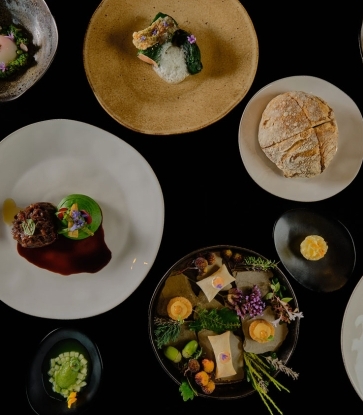With a sunny amber hue and a singularly tart kick, cloudberries are unlike any other berry. "As a Swedish people, we say it's the gold of berries," says Emma Bengtsson, executive chef of New York City's Aquavit. "You can't get a better berry. They have a freshness and acidity, but still have a natural sweetness to balance that. As soon as you try one, that memory will stick with you for life."
Sometimes referred to as yellowberry, salmonberry or bakeapple, cloudberries (rubus chamaemorus in Latin) grow in boggy areas of Arctic and subarctic regions, appearing for just a few weeks in the summertime. Starting out white and turning red, pickers know they're fully ripe when the berry reaches a golden color. Prevalent throughout Scandinavia—where they are highly prized—cloudberries can also be found in the upper reaches of Britain and Ireland, the Baltic states, northern Russia, Canada and Alaska. Generally, they only grow in the wild and need to be foraged, though efforts are being made to cultivate them commercially.
Chefs love cloudberries, often using them in preserves and desserts. You can drink them, too, as they're also transformed into liqueurs and used to flavor beer. This past season, three-MICHELIN-starred Maaemo in Oslo, Norway, turned them into a jam to accompany its dessert of Norwegian waffles cooked in aged beef fat. And noma in Copenhagen is well-known for its cold cloudberry soup dessert with a snowy island of frozen yogurt and miniature candied pine cones.

However, cloudberries are a rarity here in the States. "I've only seen it in a sweet, sugary jam at IKEA," says Bengtsson. Unable to source fresh cloudberries, she is forced to settle for frozen fruit. "[It's] an annoyance, but you do the best with what you have."
They arrive in five-pound buckets, which set her back about $400 each. However, the true cost is even more. The fruit has less than a 50 percent yield due to the fact that the berries have large seeds that need to be removed. Processing the fruit's flesh is a delicate procedure. "If you overturn them in a mixer, it gets very bitter and it takes on a grayish brown color," she says. "Neither of which is very appealing."
Bengtsson usually transforms the fruit into purées, jams, sauces or ice creams. No matter how they appear on the menu, they always prompt a lot of questions from guests who are being exposed to them for the first time. "It's fun to educate and open people's minds up," says Bengtsson.
George Mendes, executive chef of Aldea in New York, first tasted cloudberries at noma and while visiting food festivals throughout the Nordic region. "They stayed in the back of my mind," he says. "Us chefs are always looking to be surprised, and cloudberries [do just that]." Now he is using a cloudberry jam as a glaze on salt baked Badger Flame beets to go with seared scallops. "The jam contributes a citrusy note," he says, "and adds a tartness, like a lemon or a lime."
Americans who want to get a taste of cloudberries without traveling to a restaurant serving them can purchase cloudberry preserves and liqueur online.




















